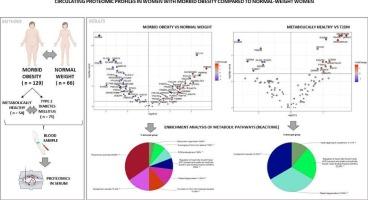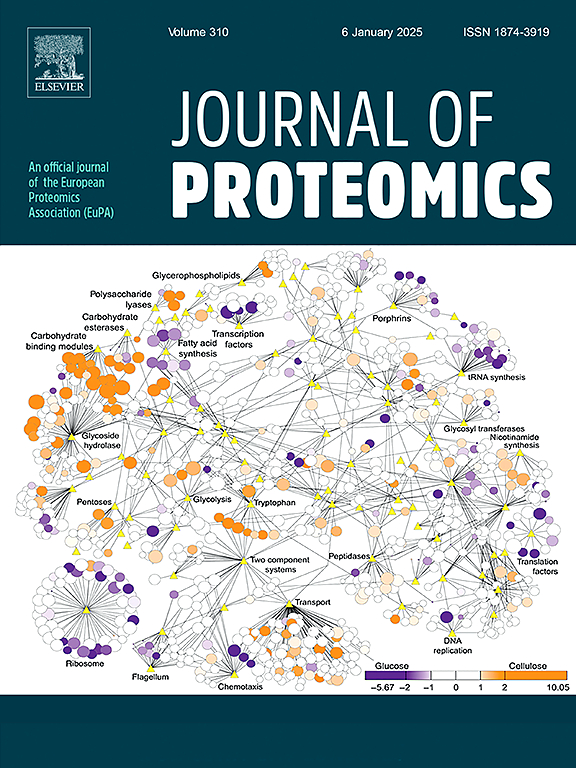Circulating proteomic profiles in women with morbid obesity compared to normal-weight women
IF 2.8
2区 生物学
Q2 BIOCHEMICAL RESEARCH METHODS
引用次数: 0
Abstract
In this study, we aimed to evaluate circulating proteomic levels in women with morbid obesity (MO) compared to normal-weight (NW) women. Moreover, we have compared the proteomic profile between women with metabolically healthy (MH) MO and those with type 2 diabetes mellitus (T2DM). The study included 66 normal-weight (NW) women and 129 women with MO (54 MH and 75 with T2DM). Blood samples were processed for proteomics, involving protein extraction, quantification, digestion with peptide labelling and Nano (liquid chromatography (LC)-(Orbitrap) coupled to mass/mass spectrometry (MS/MS) analysis. Statistical analyses were performed. We identified 257 proteins. Women with MO showed significantly increased levels of 35 proteins and decreased levels of 45 proteins compared to NW women. Enrichment analysis of metabolic pathways revealed significant findings. Women with MO have an altered proteomic profile compared to normal-weight women, involving proteins significantly related to chylomicron assembly, complement cascade, clotting pathways and the insulin growth factor system. Regarding women with MO and T2DM compared to MHMO women, the proteomic profile shows alterations in mostly the same pathways associated with obesity. These findings confirmed in previous reports can help us better understand the pathophysiology of obesity and associated diseases.
Significance
Women with morbid obesity (MO) exhibit substantial proteomic alterations compared to normal-weight (NW) women, involving 80 proteins. These alterations are linked to significant metabolic pathways, including chylomicron assembly, complement cascade, clotting pathways and the insulin growth factor system. Additionally, women with MO and type 2 diabetes mellitus (T2DM) compared to metabolically healthy MO women share similar proteomic changes than the first comparison. These findings enhance our understanding of the pathophysiology of obesity and associated diseases, offering potential targets for therapeutic intervention.

病态肥胖妇女与正常体重妇女的循环蛋白质组图谱比较。
在这项研究中,我们旨在评估病态肥胖(MO)女性与正常体重(NW)女性的循环蛋白质组水平。此外,我们还比较了代谢健康(MH)的 MO 妇女和 2 型糖尿病(T2DM)妇女的蛋白质组概况。研究对象包括 66 名体重正常(NW)的女性和 129 名患有 MO 的女性(54 名代谢健康女性和 75 名 T2DM 患者)。对血液样本进行了蛋白质组学处理,包括蛋白质提取、定量、肽标记消化和纳米液相色谱(LC)-(Orbitrap)耦合质谱/质谱(MS/MS)分析。并进行了统计分析。我们确定了 257 种蛋白质。与白血病妇女相比,MO 妇女的 35 种蛋白质水平明显升高,45 种蛋白质水平明显降低。代谢通路的富集分析显示了重要的发现。与体重正常的女性相比,患有 MO 的女性的蛋白质组谱发生了改变,其中涉及的蛋白质与乳糜微粒组装、补体级联、凝血通路和胰岛素生长因子系统有明显关系。患有 MO 和 T2DM 的女性与患有 MHMO 的女性相比,其蛋白质组图谱显示,与肥胖相关的通路大多发生了改变。这些研究结果在之前的报告中得到了证实,有助于我们更好地了解肥胖及相关疾病的病理生理学。意义:与正常体重(NW)女性相比,病态肥胖(MO)女性的蛋白质组发生了重大改变,涉及 80 种蛋白质。这些改变与重要的代谢途径有关,包括乳糜微粒组装、补体级联、凝血途径和胰岛素生长因子系统。此外,与代谢健康的 MO 妇女相比,患有 MO 和 2 型糖尿病(T2DM)的妇女也有类似的蛋白质组变化。这些发现加深了我们对肥胖及相关疾病的病理生理学的理解,为治疗干预提供了潜在的靶点。
本文章由计算机程序翻译,如有差异,请以英文原文为准。
求助全文
约1分钟内获得全文
求助全文
来源期刊

Journal of proteomics
生物-生化研究方法
CiteScore
7.10
自引率
3.00%
发文量
227
审稿时长
73 days
期刊介绍:
Journal of Proteomics is aimed at protein scientists and analytical chemists in the field of proteomics, biomarker discovery, protein analytics, plant proteomics, microbial and animal proteomics, human studies, tissue imaging by mass spectrometry, non-conventional and non-model organism proteomics, and protein bioinformatics. The journal welcomes papers in new and upcoming areas such as metabolomics, genomics, systems biology, toxicogenomics, pharmacoproteomics.
Journal of Proteomics unifies both fundamental scientists and clinicians, and includes translational research. Suggestions for reviews, webinars and thematic issues are welcome.
 求助内容:
求助内容: 应助结果提醒方式:
应助结果提醒方式:


